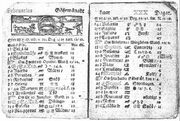
|
This page uses content from the English Wikipedia. The original article was at Swedish calendar. The list of authors can be seen in the page history. As with the Calendar Wikia, the text of Wikipedia is available under Creative Commons License. See Wikia:Licensing. |
The Swedish Calendar in use from March 1, 1700 until February 30, 1712 was one day ahead of the Julian calendar and ten days behind the Gregorian calendar.

Thirty days in February 1712.
In November 1699 it was decided that Sweden would begin to adopt the New Style, or Gregorian calendar, starting in 1700. The plan was to skip all leap days in the period 1700 to 1740, thus gradually approaching the Gregorian Calendar over 40 years. According to plan February 29 was omitted in 1700, but no further reductions were made in the following years. In January 1711, King Charles XII declared that Sweden would abandon the calendar, which wasn't in use by any other nation nor had achieved its objective, in favor of a return to the Old Style. An extra day was added to February in the leap year of 1712, thus giving it a unique 30 day length.
In 1753 Sweden introduced the New Style, whereby the leap of 11 days was accomplished with February 17 being followed by March 1. Despite this, Sweden did not accept the Gregorian rules for determining Easter until 1844; from 1753 until then, Sweden observed Easter on the Sunday after the first astronomical full moon after the true vernal equinox.